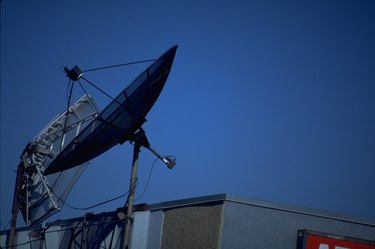
Signal strength for a satellite television connection is inherently important to operation of the dish, as signal clarity will directly impact satellite TV reception and may impair it to the point that enjoyment of your connection is impossible. Fortunately, the satellite receiver box includes a digital signal meter screen utility that allows you to test your signal strength and make suitable corrections to your satellite dish's orientation to improve signal reception.
Step 1
Ensure the satellite dish is connected to the included satellite receiver box. The receiver box should be set up by the television. Take the coaxial cable that comes out of the rear of the dish's mast and lead it inside to the back of the receiver box, where the "ANT IN" port resides. Plug the coaxial cable in here.
Video of the Day
Step 2
Connect the satellite receiver box to your television. This box has red, white and yellow composite ports on its back. Your television has matching ports. Conveniently, your receiver box ships with a composite cable that features two sets of red, white and yellow plugs, one on either side. Connect one set of these plugs into the television's composite ports and the other into the receiver's set.
Step 3
Ensure that both the satellite receiver and television are powered on. A menu will appear on the TV when the receiver has finished booting.
Step 4
Select the "Signal Meter Screen" option from the receiver menu.
Step 5
Return to the satellite dish outside and have an assistant stay with the meter screen to monitor signal strength changes.
Step 6
Create slight, incremental up/down orientation (elevation) changes to the dish every 5 to 10 seconds. In the interim between each incremental adjustment, the signal meter screen will update by reading your new dish orientation and indicating how strong the current signal is and how close you are to pointing your dish to the correct coordinates. Continue making elevation changes as directed to achieve a stronger signal.
Step 7
Create slight, incremental left/right orientation (azimuth) changes to the dish every 5 to 10 seconds, again waiting for signal meter screen updates. Continue making elevation and azimuth changes until the meter screen indicates you have hit the proper coordinates. This will result in an optimal signal.
Step 8
Ensure there are no obstructions around the satellite dish or above it that may impair its line of sight to the open sky above, as this will significantly and negatively impact satellite signal reception. The area around your dish should be clear of obstructions such as power lines, trees and tall buildings.
Video of the Day